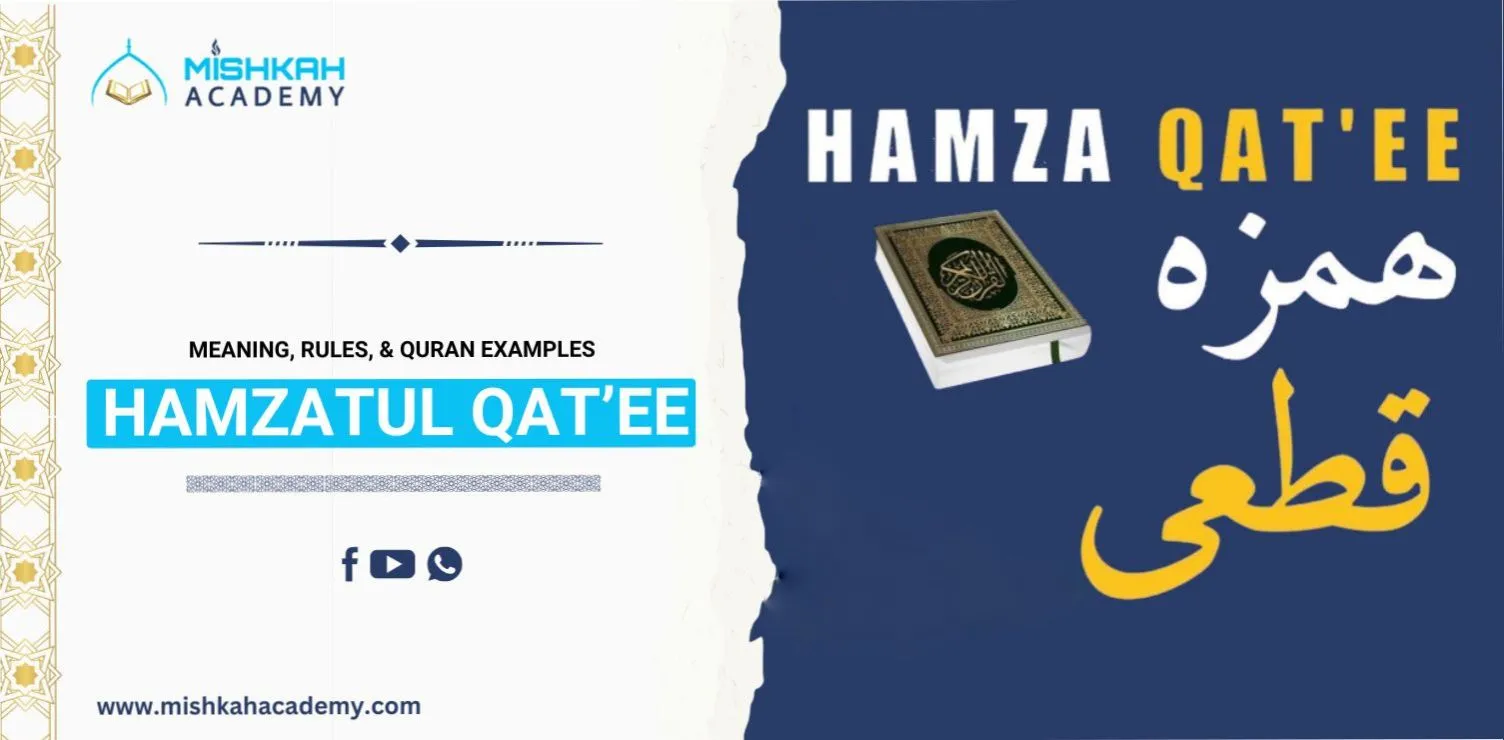One of the most important ideas in Arabic phonetics and grammar is Hamzatul Qat’ (همزة القطع). This is the “cutting Hamzah” or the permanent Hamzah, which is always uttered, no matter where it occurs in a word. This separates it from Hamzatul Wasl (همزة الوصل), which cannot be used when attached to a word that comes before it. Gaining fluency in spoken Arabic and correctly pronouncing Arabic, particularly in Tajweed (the art of reciting the Qur’an), requires an understanding of Hamzatul Qat.
In contrast to Hamzatul Wasl, which connects words easily, “Hamzatul Qat'” literally means “Hamzah of cutting,” suggesting that it disturbs the speech’s natural flow. Regardless of whether a word is at the start, middle, or end of a sentence, Hamzatul Qat’ is a fixed sound that must be expressed correctly due to its persistent presence.
Definition of Hamzatul Qat’
Table of Contents
ToggleHamzatul Qat’ is a pronounced glottal stop that can be found in nouns, verbs, and particles, among other word kinds. In order to convey its permanent presence, the term is always written with a visible Hamzah (ء). The Hamzatul Qat’ is a crucial component of Arabic phonetics since it is always uttered regardless of whether the word comes before or after another in the sentence.
Hamzatul Qat’ is vital for Tajweed because it guarantees that the Qur’an is recited correctly. The Hamzatul Qat’ can cause major meaning alterations and break the flow of Qur’anic verses if it is mispronounced or ignored. Thus, it is crucial for everyone learning Arabic to understand the principles of Hamzatul Qat’, particularly for accurately reciting the Qur’an.
Hamzatul Qat’ Rules
Proper pronunciation of Hamzatul Qat’ requires an understanding of its guidelines. In contrast to Hamzatul Wasl, which may be missed depending on the word’s position, Hamzatul Qat’ adheres to a set of regulations that guarantee it is always expressed. The following are the main guidelines for Hamzatul Qat’:
-
Always Pronounced
Hamzatul Qat’s main rule is that it must always be uttered, whether it comes at the start, middle, or end of a word. It is not possible to drop Hamzatul Qat’ under any condition.
For instance, whether the word “أحمد” (Ahmed) comes at the beginning or the middle of a sentence, the Hamzah is always uttered.
-
Present in Nouns, Verbs, and Particles
Hamzatul Qat’ can occur in nouns, verbs, and particles. It is always marked with the visible Hamzah (ء) symbol to indicate that it must be articulated.
- Example in a Noun: “أمل” (hope) – The Hamzah is pronounced regardless of its position in the sentence.
- Example in a Verb: “أَكَلَ” (He ate) – The Hamzah is always pronounced.
- Example in a Particle: “أنْ” (that) – The Hamzah is pronounced every time.
-
Written as a Visible Hamzah (ء)
In written Arabic, Hamzatul Qat’ is represented by a visible Hamzah (ء) placed on Alif (ا), Waw (و), or Ya (ي) depending on the vowel that follows. It is a clear indicator that the Hamzah must be pronounced.
- Example on Alif: “أَمَامَ” (in front) – The Hamzah is written on an Alif and pronounced.
- Example on Waw: “أُسْتَاذ” (teacher) – The Hamzah is written on a Waw and pronounced.
- Example on Ya: “إِيمَان” (faith) – The Hamzah is written on a Ya and pronounced.
-
Pronounced with Strong Emphasis
Strong vocal cord articulation, or a glottal stop, is necessary for Hamzatul Qat’. By doing this, the Hamzah is guaranteed to be audible and distinct from other letters or vowels.
-
Pronunciation at the Start of a Sentence
Hamzatul Qat’ is pronounced as the word’s initial sound, introducing it with a distinct glottal stop, when it appears at the start of a phrase.
For instance, “أَعْلَمُ” (I know) – The Hamzah is spoken clearly if this word starts a sentence.
-
Stays Pronounced in Connected Speech
The Hamzah is still pronounced even if the word that contains Hamzatul Qat’ comes after another word. Unlike Hamzatul Wasl, which is left out of connected speech, it never drops.
For instance, the Hamzah in “أحمد” is spoken even if it is in the middle of the sentence “رأيتُ أحمدَ” (I saw Ahmed).
Note: Enroll in the Advance tajweed course to learn all Hamzatul Qat’ rules with expert egyptian quran tutors.
Start Your Quran Journey NowHamzatul Qat’ Types
Hamzatul Qat’ appears in a variety of word kinds. Knowing these kinds makes it easier to determine when the Hamzah should always be pronounced.
1. Hamzatul Qat’ in Nouns
Many nouns in Arabic begin with Hamzatul Qat’. Common words like proper names, simple terms, and more complex nouns are examples of these nouns.
For instance:
The Hamzah is pronounced “أَسَد” (lion).
Pronounce the Hamzah on the Ya as “إِنسَان” (human being).
-
Hamzatul Qat’ in Verbs
Hamzatul Qat’ is the first word of several verbs, particularly those in the present and past tenses. The Hamzah must be spoke in these situations since it is a vital part of the verb.
Examples:
“أَكَلَ” (He ate) – The Hamzah in the past tense verb is pronounced.
“أُحِبُّ” (I love) – The Hamzah in the present tense verb is pronounced.
-
Hamzatul Qat’ in Particles
Additionally, particles—small words with grammatical meaning but no ability to stand alone as whole sentences—can contain Hamzatul Qat’.
Examples:
“إِنَّ” (Indeed) – The Hamzah is pronounced.
“أَنْ” (that) – The Hamzah is pronounced.
Examples of Hamzatul Qat’ in the Qur’an
There are several instances of Hamzatul Qat’ throughout the Qur’an, therefore it is crucial to pronounce this Hamzah correctly when reciting the Qur’an. Here are a few instances of Hamzatul Qat’s appearance in the Qur’an:
1. Surah Al-Fatiha (1:1)
“الْحَمْدُ لِلَّهِ رَبِّ الْعَالَمِينَ”
In the word “الْحَمْدُ” (praise), the Hamzah is Hamzatul Qat’, meaning it is always pronounced, whether at the start or in the middle of a sentence.
2. Surah Al-Ikhlas (112:1)
“قُلۡ هُوَ ٱللَّهُ أَحَدٌ”
The word “أَحَدٌ” (one) contains Hamzatul Qat’, and the Hamzah is pronounced clearly regardless of where the word appears.
3. Surah Al-Baqarah (2:255)
“ٱللَّهُ لَآ إِلَٰهَ إِلَّا هُوَ”
The word “إِلَٰهَ” (god) begins with Hamzatul Qat’, and the Hamzah is always pronounced.
Difference Between Hamzatul Qat’ and Hamzatul Wasl
Given their distinct roles in Arabic speech and grammar, it’s critical to understand the distinction between Hamzatul Qat’ and Hamzatul Wasl:
1. How to pronounce
- No matter where it appears in a word or sentence, Hamzatul Qat’ is always pronounced. It disrupts speech by acting as an always glottal stop.
- Only when it starts a sentence or comes after a pause is Hamzatul Wasl uttered. It is dropped in connected speech.
2. Writing
- Depending on which vowel comes after it, Hamzatul Qat’ is always written as a visible Hamzah (ء) on Alif (ا), Waw (و), or Ya (ي).
- When not required for pronunciation, Hamzatul Wasl, which is written as a little mark on Alif (ا), disappears from the permanent word structure.
3. Function in Speech
- Hamzatul Qat’ breaks the flow of speech by introducing a clear glottal stop.
- Hamzatul Wasl helps in connecting words, ensuring a smooth flow of pronunciation.
4. Usage in the Qur’an
- Hamzatul Qat’ appears in many Qur’anic verses and is crucial for proper quran recitation.
- Hamzatul Wasl also appears in the Qur’an but is often omitted when the word is connected to a preceding word.
Importance of Hamzatul Qat’ in Tajweed
In Tajweed, the science of Qur’anic recitation, mastering the pronunciation of Hamzatul Qat’ is essential. Mispronouncing or neglecting this type of Hamzah can lead to changes in meaning and disrupt the flow of recitation.
Tajweed rules ensure that Hamzatul Qat’ is pronounced where required, preserving the Qur’an’s sacred language. It is crucial to follow the correct pronunciation rules to avoid errors, especially in words where the omission of the Hamzah could alter the intended message.
Conclusion
A vital part of Arabic phonetics, grammar, and Qur’anic recitation is Hamzatul Qat’. It helps to guarantee that words and phrases are pronounced correctly and clearly, which is crucial for maintaining their intended meaning. In contrast to Hamzatul Wasl, which is sometimes deleted, Hamzatul Qat’ is consistently uttered, making it a permanent aspect of the term. Anyone learning Arabic or Tajweed must become skilled in the rules and application of Hamzatul Qat’, as this ensures accurate recitation and understanding of the quran.
For those looking to deepen their understanding of Hamzatul Qat’ and other aspects of Qur’anic recitation, enrolling in an online Tajweed course can be highly beneficial. This structured learning approach helps to master the rules of Tajweed, including the nuances of Hamzatul Qat’, and improves one’s recitation accuracy.
Start Your Quran Journey Now





